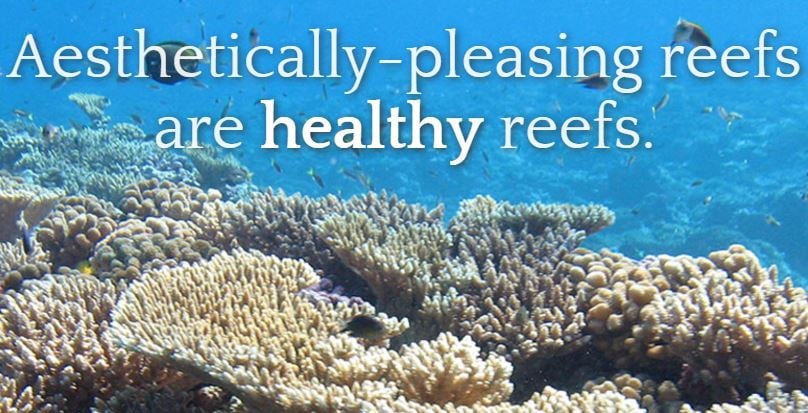Beautiful coral reefs tend to be healthier than less pretty or plain ugly ones, according to an objective computational analysis of photographs. Most of us, when we look at natural environments, find the healthy and thriving ones prettier than locations which are becoming degraded.
Art historians and philosophers the world over have long searched for universally valid criteria for aesthetic principles, i.e. a way of quantitatively describing beauty and ugliness.
Art history, biology and mathematics researchers from the Getty Research Institute, San Diego State University, the Scripps Institution of Oceanography, the Université de Paris-Saclay, Caribbean Research and Management of Biodiversity (CARMABI), the University of Amsterdam, and the College of Charleston, say the development of a powerful new computational approach will pave the way for a more comprehensive assessment of what we find aesthetically pleasing.
 Kingman reef, a remote, uninhabited reef system located in the Central Pacific half way between the Hawaiian Islands and American Samoa, is an example of a healthy reef. (Image: www.sensiphi.com. Credit: Jennifer E Smith)
Kingman reef, a remote, uninhabited reef system located in the Central Pacific half way between the Hawaiian Islands and American Samoa, is an example of a healthy reef. (Image: www.sensiphi.com. Credit: Jennifer E Smith)
They have created a tool that computationally measures how beautiful coral reefs are. Their results show that objective visual cues generated from randomly-selected photographs can be used reliably to asses both the health and beauty of coral reefs across the world.
Computer program gives coral reefs a beauty score
The researchers, who published their findings in the scientific, open-access, academic journal PeerJ, compiled and modified a list of 109 visual features, which they claim can be used to assess the aesthetic appeal of a photograph, such as the color, relative size, and distribution of discernable objects within the picture, as well as color intensity and texture.
They then developed a computer program that can assess these features within images, and used it to analyze over 2,000 random photographs of coral reefs from different parts of the world.
The program gave an aesthetic score for each reef ecosystem.
Lead researcher, Andreas Haas, a San Diego State University post-doctoral scholar, explained that their findings show striking similarities between the aesthetic scores of randomly-selected reef images and the health of the respective reef ecosystem, after being evaluated scientifically.
 A house and garden before and after Hurricane Katrina struck in 2005. All humans would say that the picture on the left is much prettier than the one on the right. Our perception of beauty is closely associated with the health of a place. (Image: hurricanescience.org)
A house and garden before and after Hurricane Katrina struck in 2005. All humans would say that the picture on the left is much prettier than the one on the right. Our perception of beauty is closely associated with the health of a place. (Image: hurricanescience.org)
Perceived beauty and actual health are closely linked
Dr. Haas said:
“Our results suggest that our perception of aesthetics is well-aligned with healthy, thriving ecosystems.”
The study shows that our perception of aesthetic value is not completely subjective, but closely linked to the inherent components of nature that indicate healthy or degraded states.
Perhaps this tool could be used by ecologists as a quick and economical approach to monitoring the status and health trajectories of coral reef ecosystems.
Dr. Haas said:
“By quantifying aesthetic features of coral reef systems, this method provides a cost effective tool that also targets one of the most important socioeconomic values of coral reefs – their natural beauty.”
In many ways, our five senses guide us to seek healthy objects and environments and avoid unhealthy ones. Most rotting foods (which are hazardous to our health) have a repugnant odor for humans.
You can upload an image to a website created by the researchers and get an aesthetic score back.
Citation: “Can we measure beauty? Computational evaluation of coral reef aesthetics,” Andreas F. Haas, Marine Guibert, Anja Foerschner, Tim Co, Sandi Calhoun, Emma George, Mark Hatay, Elizabeth Dinsdale, Stuart A. Sandin, Jennifer E. Smith, Mark J.A. Vermeij, Ben Felts4, Phillip Dustan, Peter Salamon and Forest Rohwer. PeerJ. November 10, 2015. DOI: https://dx.doi.org/10.7717/peerj.1390.

